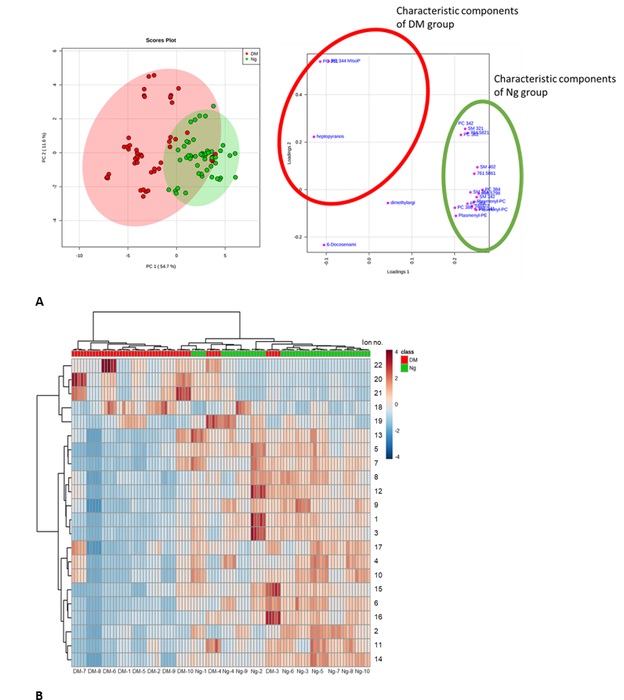Reviewed by Danielle Ellis, B.Sc.Mar 2 2022
One of the most important and difficult aspects of a forensic examination is identifying the cause of death. Knowing the decedent’s medical records can make this process much easier, and it can even assist forensic pathologists to figure out the deceased’s state prior to death.

A. Score and loading plots of PCA. 10 samples from the DM GROUP (red) and 10 samples from the negative (NG) group (green) are plotted based on 22 ions with statistical significance in the analysis targeting hydrophilic substances. The loading plot corresponds to the PCA score plot, with one plot representing a single ion. From this plot, it is possible to visually understand what the characteristic components are for the DM and NG groups, respectively. B. Heat map analysis of metabolomics for hydrophilic substances. The row displays the ions, and the column represents the samples. Ions with significantly lower levels are displayed in blue, while ions with significantly higher levels are displayed in red. The brightness of each color corresponds to the magnitude of the difference when compared to the average value. The samples roughly form clusters of DM group (red) and NG group (green). Image Credit: Maika Nariai, The University of Tokyo.
However, in other cases, such as in the event of an undiagnosed condition, this data may not always be available. For instance, diabetes mellitus (DM)—a major chronic illness with a large prevalence across the globe—is extremely hard to diagnose postmortem as a cause of death, particularly when the decedent’s health history is unavailable prior to the autopsy. Each of the current biochemical methods for diagnosing DM after death has its own set of limitations.
Metabolomics, or the study of metabolites like sugars, amino acids, and lipids in biological systems, is a quickly evolving tool in the field of precision medicine. From colorectal cancer to depression, metabolomic research has been utilized to detect complicated disorders.
To date, however, the majority of research has employed a metabolomic method to look for illness biomarkers in samples from living people. While postmortem metabolomic analysis has not been researched extensively, it could provide a far more consistent way of diagnosis.
This idea prompted a team of scientists, including Ms Maika Nariai, a medical student at the time of the study from The University of Tokyo’s Department of Forensic Medicine, to use metabolomic assessment to find postmortem biomarkers indicating a decedent’s DM history.
Dr Yohsuke Makino of the University of Tokyo’s Department of Forensic Medicine and Dr Hiroko Abe, Dr Yumi Hoshioka, and Prof. Hirotaro Iwase of Chiba University’s Department of Legal Medicine were part of the research team. The study’s findings were recently published in The International Journal of Legal Medicine.
Between 2014 and 2017, the researchers autopsied 10 participants with a history of DM and another 10 participants with no verified record of DM at a legal medicine department in Japan. Researchers used metabolomic testing on postmortem blood samples to look for biomarkers that could indicate a history of diabetes.
Surprisingly, they discovered that two classes of lipids, sphingomyelin and plasmalogens, were significantly lower, while lysophospholipids were considerably higher, in subjects with DM compared to those without a known history of DM, implying that these metabolites can be used as biomarkers for forensic assessment of DM.
Addressing this result, Ms Nariai states, “Our findings have the potential to boost metabolomics research in forensic science and lead to the improvement of the quality of forensic investigations by precisely diagnosing diabetes even after death. It can also help improve public health and reduce false accusations.”
So, what are the long-term consequences of these discoveries?
Ms Nariai responds, “The forensic diagnostic markers for other diseases and conditions may be found if further research on metabolomics using postmortem samples is conducted. This will be useful in investigating cases where the cause of death is not clear. Moreover, metabolomics of postmortem samples may also provide new insights into the diagnosis and treatment of various diseases and a better understanding of changes after death.”
With more study using postmortem samples, the research group is sure that metabolomics would become a beneficial contributor to a forensic pathologist’s toolset. “In addition to blood, we think that other postmortem samples, such as hair, urine, and vitreous humor, may provide useful results for biomarker identification,” Ms Nariai concludes.
Source:
Journal reference:
Nariai, M., et al. (2022) Biomarker profiling of postmortem blood for diabetes mellitus and discussion of possible applications of metabolomics for forensic casework. The International Journal of Legal Medicine. doi.org/10.1007/s00414-021-02767-w.